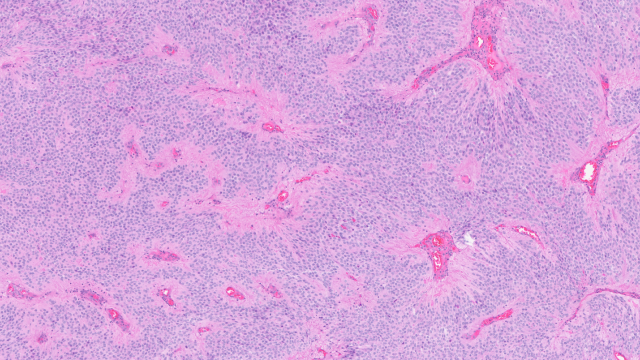An AI tool predicts tumor response to targeted therapy using single-cell datasets.

Artificial intelligence can take vast amounts of data and process it into something that researchers can use. CCR researchers have developed a new AI model, called PERCEPTION, to analyze RNA sequencing data from individual tumor cells and predict if the tumor will respond to a broad array of cancer targeted therapies. This new precision oncology approach offers exciting new ways to match cancer patients to the best possible therapies in a more accurate manner.
Credit: Donny Bliss, NIH Medical Arts; SPGM, FNL, NCI, NIH; Adobe Firefly
A new artificial intelligence (AI) tool called PERCEPTION analyzes single-cell RNA sequencing (scRNA-seq) data from tumors and predicts whether a patient will respond to a specific targeted treatment. PERCEPTION also identifies when patients’ tumors are likely to develop resistance to treatment — and even provides drug recommendations to combat it.
Different cancer treatments target different elements of tumor biology, and not every treatment will work against each tumor. In response to this challenge, Senior Investigator Eytan Ruppin, M.D., Ph.D., develops AI programs that analyze tumor data to match patients with treatments that will be most effective. A postdoctoral fellow in his lab, Sanju Sinha, Ph.D., who is now an Assistant Professor at Sanford Burnham Prebys in La Jolla, CA, was interested in applying this approach to scRNA-seq data from tumors.
Single-cell RNA sequencing generates a molecular profile for each cell in a sample, and can shed light on tumor heterogeneity, or the fact that not all cells in a tumor are the same. Cells in one area of a tumor may have a different molecular profile than cells elsewhere in the tumor. This makes choosing anti-cancer therapy difficult because it may only be effective against some, but not all, of the cancer cells in a tumor, and the surviving cells could allow the tumor to grow and spread.
Because it is looking at tens of thousands of individual cells, scRNA-seq creates large volumes of complex data that is challenging to interpret. However, AI can help interpret this data all at once and connect it to clinical outcomes. “That's why we wanted to use AI to see if we can use tumor single-cell RNA sequencing to predict therapy response, as well as track resistance,” explains Sinha.
To this end, the researchers developed an AI method, PERCEPTION (PERsonalized Single-Cell Expression-Based Planning for Treatments In ONcology), and used it to analyze scRNA-seq datasets of patients’ multiple myeloma, breast and lung cancer tumors. Importantly, some of the data contained scRNA-seq data before and after treatment, showing how different cells within tumors responded to therapy.
In a study in Nature Cancer, they show how PERCEPTION helps to predict which anti-cancer drugs are most effective for individual patients. What’s more, it was able to track the evolution of drug resistance over the course of a patient’s disease — which Sinha notes is the first time a tool has demonstrated such capabilities — and outperform all other existing predictive tools for matching patients and treatments.
PERCEPTION can be applied to other cancer types where scRNA-seq data and matching clinical outcome data exists. Although scRNA-seq is expensive and future studies are needed to verify PERCEPTION’s abilities, the initial findings suggest that the tool could open new avenues for precision oncology.
“Treatment of patients would be more adaptive, in terms of taking more measurements, looking at how the tumor is changing over time, and changing the treatment accordingly,” explains Alejandro Schäffer, Ph.D., a Staff Scientist in Ruppin’s lab who helped develop PERCEPTION.
Sinha adds that this work was possible because of his mentors and the environment at CCR. “I really thank Eytan, Alejandro and CCR for providing a space where, as a young scientist, I was able to be bold and creative,” he says.



